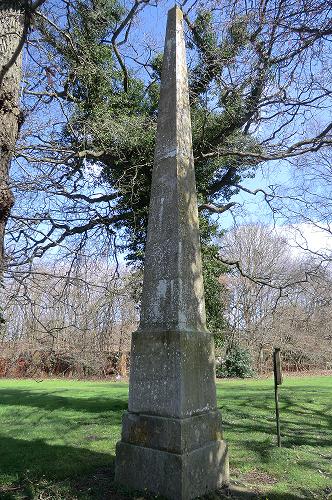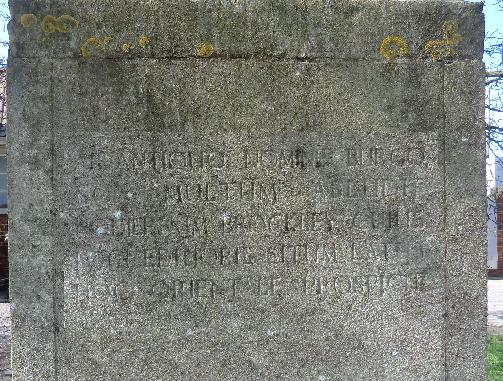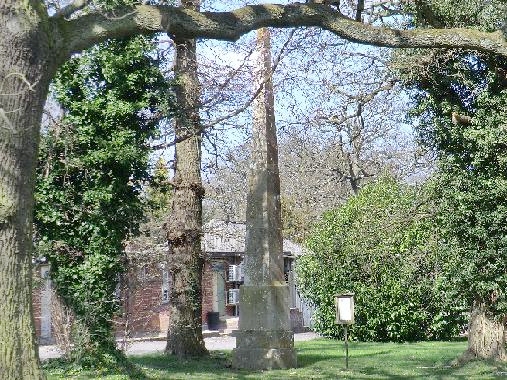The Stanmore Obelisk, Brockley Hill..
The memorial commemorates a battle in which the British tribes united under the leadership of the King Cassivellaunus defeated the Roman Legions under the leadership of Julius Caesar during his second invasion Britain in B.C.54. In 1928 The Royal National Orthopaedic Hospital purchased 70 additional acres of land and in doing so inherited this historic monument which stands near the top of Brockley Hill.
The site at the top of Brockley Hill Stanmore was once the Roman township and settlement of Sulloniacae, situated nine Roman miles from St Albans (Verulamium) and 12 miles from London. A large part of the site now falls within the grounds of The Royal National Orthopaedic Hospital. Sulloniacae was a major production centre for flagons and ancient Roman pottery kitchen vessels called mortaria. The mortarian potters stamped their names on the pots and as a result these items have been identified over a wide area of the south east.
This site was once the scene of an epic battle when the British tribes united under the leadership of the King Cassivellaunus defeated the Roman Legions under the leadership of Julius Caesar during his second invasion Britain in B.C.54. Cassivellaunus was said to be a shrewd military leader whose subsequent handling of his forces and his use of guerrilla tactics, is what prevented Caesar from achieving the total victory over these lands that he was seeking.
The Obelisk was erected in 1750 as a memorial to what happened here by William Sharpe who was secretary to the second Duke of Chandos. In 1928 The Royal National Orthopaedic Hospital purchased 70 additional acres of land and in doing so inherited this historic monument which stands near the hop of the hill. At some time in history the original inscriptions had been lost, so when The Royal National Orthopaedic Hospital took ownership of the land, they restored the obelisk and had new inscription stones made.

Next to the monument is a small notice which explains the history of the obelisk in great depth:
The Obelisk stands on what was the territory of the Catuvellauni, a dominant Celtic tribe whose king was Cassivellaunus, or Caswallon, as known to his people. The tribe occupied an area which is now Hertfordshire, Berkshire and Buckinghamshire, with the capital at Wheathampstead.
Julius Caesar invaded Britain with two legions in B.C.55, but went no further than Kent. In B.C.54 Caesar came again with five legions and 5000 cavalry and met strong resistance from the men of Kent. He crossed the Thames and advanced along a trackway through the forest. The fair-headed Britons in their scythed war chariots harassed the Roman columns. The legions also met string resistance from the Brythonic settlement and fortification of Sulloniacae whose site is near to the entrance to the Hospital grounds. It is conceivable that the Celtic inhabitants had dedicated their habitation to the goddess Sulis. It is not known what they named their settlement; Sulloniacae was the Roman way of rendering its Celtic name. The Roman army only advanced as far as Wheathampstead which was heroically defended by Cassivellaunus. After imposing a tribute Caesar and his army returned to Gaul. The tribute soon ceased to be paid.
Almost a century passed before another invasion took place although during the interval there was much intercourse between Britain and the Continent. The conquest of Gaul brought with it Latin civilization and Britain came within the orbit of Roman influence. In A.D.43 the Emperor Claudius began the conquest of Britain. He came with his troops along the road known as Sara Gwyddelin which means the Irish Highway. It went from Dover to Holyhead passing close to Sulloniacae on its way. The Romans spoke of "Gwyddelin" as "Weatlinga" which again became "Watling" to succeeding generations and thus "Sara Gwyddelin" became known as "Watling Street."
After the conquest the Romans usually allowed the tribes to be governed by their native rulers and the Celtic aristocracy were encouraged to adopt Roman dress, to speak Latin and were recognized as Roman citizens. By this means the goodwill of the native population was obtained and it continued for over three and a half centuries. Indeed the forced departure of the Romans in 410 by the threat to Rome by Alaric and the Goths was deplored. The Roman occupation left a permanent impression on the native language. Over 2000 Latin words were added to the Welsh vocabulary (e.g. "church" in Welsh is "eglwys", "bridge" is "pont" and "window" is "ffenestre.")
With the departure of the Romans the city of Gwerlam or Verulamium near the present St. Albans, ceased to be occupied. Its Roman bricks were used in the building of the great abbey.

TRANSLATION OF INSCRIPTIONS:
ON THE SOUTH SIDE (front)
Near this place once stood the stronghold and township of the Suellani, a position splendidly fortified by nature and art. This tribe, under the leadership of Cassivellaunus, defeated the Romans. Caesar in his commentaries has put on record forever the greatness and renown of this British general, to whom by common consent the supreme command and conduct of the war has been entrusted.
This obelisk marks the midway point between Londinium (London), once a town of the Tribobantes and Verulamium (St. Albans) the principal township of the Cassi.
ON THE EAST SIDE
The present name of Brockley is not very different from the ancient Burgus, the higher ground towards which the eastern side looks.
ON THE WEST SIDE
This western side faces the old settlement of the Cassi, now called Cassiobury.
ON THE NORTH SIDE
Burgh Wood so called from Burgus, the stronghold of the leader Cassivellaunus, lies to the north.
To visit the monument the nearest post code is HA7 4LE follow wood lane about half way down and you will see the entrance to RNOH car park opposite wood farm. Park in the free car park and take the path to the top of the hill.
